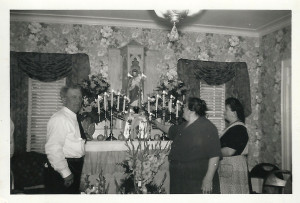So I’ve discovered what many of you may already know: there are no hard and fast rules for grieving. I find myself mostly going through my days, doing what needs doing, but feeling a bit like my gears are not aligned quite right. Inspiration is tough to come by, as is enthusiasm. There are certain things lately that make me uneasy: suburban Delray Beach, hospitals in general (I had to visit one last week for a medical test, and it felt a bit too soon), and straws: I unwrapped so many straws for my father in the last few weeks of his life, sometimes six or seven in a visit. Protein shake, orange juice, ginger ale, water… for each I would carefully tear the paper wrap from around the middle of the straw, remove one end of the wrapper while I held the other, then put the straw into his drink and remove the rest of the paper. It’s fine if my drink arrives at my table with a straw already in it, but there was an instance two weeks ago where my waitress brought me a drink and a straw on the side and as I went through those same motions again––tearing the paper, holding one end while removing the paper at the other––well… suddenly it felt too soon for straws, too.
But life goes on, of course. We’ve had quite a few celebrations with family and friends, honoring my dad, for even a funeral is a celebration of life. It is one of the ceremonies of our days, a hugely important one, I’ve found. And Dad, I’m sure he was shaking his head sometimes at his kid who was encouraging him to celebrate ancient Roman holidays and the birthdays of those who have passed. He always went along with our ways, though, maybe only because he liked a good meal. This week, though, we come to some celebrations he really enjoyed, and these will be the first traditional holiday celebrations we’ll have where he won’t be seated at the table. That will be strange, I know. But we will get through that strangeness, and we will raise our glasses to him, and we will conjure his presence as best we can. One foot in front of the other. It is what we do.
And so this week come three saints’ days: St. Patrick’s Day, the day when everyone is at least a little bit Irish; St. Urho’s Day, for the Finns; and St. Joseph’s Day, when we Italians feast (imagine that)… but mainly on one very particular pastry, the zeppole.
The day before St. Patrick’s Day, 1974, my mom and dad and sister flew from New York to Chicago to my Aunt Anne and Uncle Joe’s house. I was already there, a stowaway on the train that my grandparents had taken the week before. My dad arrived dressed head to toe in green: green leisure suit (it was 1974, after all), green shirt, green socks, and patent leather and suede green shoes. A woman in the elevator at O’Hare cried out, “He’s even got green shoes!” He was probably wearing green underwear, too.
Our St. Patrick’s Day celebrations since then mostly revolve around corned beef and cabbage and soda bread. My sister, through and through Italian, makes one mean soda bread. Now there’s something I’m looking forward to this week, and I’m sure it will inspire my mom to say what she always says about soda bread: “Why do we have to have this just once a year?” (She says the same about the Pan de Muertos we make each November for Dia de Muertos.)
For St. Joseph’s Day, we will have zeppole: dough, sometimes fried, sometimes baked, filled with custard and cherries. Sometimes we get sfinci, the same dough, but filled instead with a sweet ricotta cream, like they use in cannoli. I have to admit we’ve had quite a few already. When we were in New York last week for my father’s burial, cousins inundated us with Italian pastries, and already there were zeppole and sfinci, even in early March. The 19th of March, though, is St. Joseph’s Day, and this is the proper day to eat them.
Before both St. Patrick’s Day and St. Joseph’s Day, though, comes St. Urho’s Day on the 16th. Urho is a fictional saint, and you have to be Finnish or amongst Finns to know him. I know him only because I live here in Lake Worth, home to more Finns than anywhere but Finland. How do these things happen, I wonder? Why did so many Finns come to this town? The Finns love cardamom and smoked salmon and saunas and so many of our local homes have saunas in them because of them. And some of these very same Finns will be celebrating St. Urho, the saint who drove the grasshoppers from Finland. If this sounds a lot like the guy who drove the snakes from Ireland, well… that’s the point of this fictional saint whose day comes just before that of the more famous Patrick.
It’s been decided the family will gather here at our house for St. Patrick’s Day dinner, which means I’ll be doing the cooking, and then at my family’s home for St. Joseph’s Day dinner, and this makes me happy, that even in loss and grieving, we can come together and celebrate. There are the things that make me uneasy lately but also just as many things that carry me forward: the love I feel from family and friends, all of you included. Your words of kindness have been like a raft for me. Some music has helped me, too. My mom remembers in times of mourning when she was a kid that even listening to the radio was forbidden, but one day not long after Dad died when I was at home at my house and she was at home in hers, we were speaking on the phone and she told me to put on some music. I did. It was the new Jane Siberry recording that my nephew gave me for Christmas, the one I hadn’t opened yet. My friend Kelly suggested it was time, and she was right. It’s called Angels Bend Closer, and it, too, has been a raft for me to float upon. It was five years between this and Jane’s last major recording release, and in that space of time, she lost her father, too, and her mother. So she gets it. She always does. Dipped just a bit in darkness and melancholy, still this collection of songs is nothing but uplifting. Jane reminds me over and over again that I always have and always will be well. Perhaps you need that reminder, too.
Image: Mom and Dad at our St. Patrick’s Day dinner table, 2008. My sister brought the hats.



